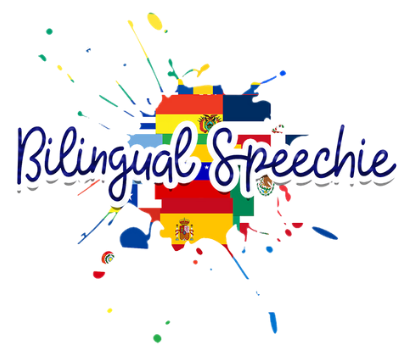por Liliana Diaz febrero 25, 2021 3 Comentarios
We already know that bilingualism is not static and it exists on a continuum in which one's proficiency is constantly changing over time. In some cases, bilingual people might be more dominant in one language when compared to the other (this is perfectly normal). As speech language pathologists, we need to be able to determine exactly where our bilingual student falls on the bilingual continuum by measuring the his/her language dominance in both languages. Why is this important and how do we do this you may ask? I will answer your questions down below:
The Importance of Measuring Language Experience & Dominance
How do I Measure a Bilingual Student's Language Experience & Dominance in Both Languages?
The best way to measure a bilingual student's language experience and dominance in both languages is by collecting an in-depth language history. The language history will allow you to gain an understanding of the student's use and exposure of both languages. You can obtain an exact percentage of the student's language use and exposure in both languages by determining who the child lives with, their relationship to the child, the languages spoken and heard by the child each hour of the day. Once you have all the information over a week's span, you can calculate the average percentage of use and exposure of both languages. There is an exact formula that you can follow to obtain the percentages. I created a visual chart, formula document with step-by-step instructions and data organization chart which is available for free download in the freebie library (click here for formula and chart). It will walk you through exactly through the formula. Once you have this information, you will be able to see exactly where your student falls on the continuum and mention it in your report.
Based on the information, you should be able to figure out whether your student is a functional monolingual English (FME), functional monolingual other (FMO), bilingual English Dominant (BED), balanced bilingual (BL), bilingual other dominant (BOD), or functional monolingual other (FMO). Remember, a bilingual evaluation is always needed for BED, BL, and BOD students. So where do your students fall on the continuum?
diciembre 13, 2023
HI! Is this resource still available?
noviembre 04, 2022
Hi Elizabeth,
I will send you an email directly. However, ensure that you are calculating the time from the moment the student wakes up to the moment the student goes to bed. For example, the student’s day might look like from 7AM to 8PM.
noviembre 04, 2022
Hi,
So I’m trying to do the math and maybe I’m doing something wrong. 80% of 168 comes out to 134.4 hours. So if I’m understanding right, they have to speak (or hear) a language 134.4 hours or 19.2 hrs out of each day to be FME or FMO. Where is sleep in this? Who talks for that many hours? Is this hours that they “may” talk or have the opportunity to talk because I don’t know anyone who talks for 19 hrs. This seems an impossible standard to meet and everyone would fall in the needing bilingual evaluation category. Do you add the hours for talking and hearing together then divide it? Please help.
Los comentarios se aprobarán antes de mostrarse.
por Liliana Diaz diciembre 14, 2023
por Liliana Diaz julio 23, 2023
Have a client on your caseload that is demonstrating difficulty producing the CH sound? Perhaps you're a parent whose child is in speech therapy working on the CH sound? The CH sound can be a tricky sound to teach because it's hard to visually see what's going on inside the mouth when saying the sound. But no worries, here are some tips to help achieve that tricky CH sound.
por Liliana Diaz febrero 13, 2023 1 Comentario

¡Bienvenidos! ¡Soy Bilingual Speechie y este es mi blog de logopedia! ¡Aquí encontrará recursos y actividades bilingües (inglés y español) para la terapia del habla y lenguaje! ¡Estoy aquí para hacerles la vida más fácil!
Mi nombre es Liliana Díaz-Vázquez y obtuve mi licenciatura en trastornos de la comunicación en 2012 y mi maestría en patología del habla y lenguaje en la Universidad Saint Xavier en 2014.
Soy patóloga del habla y lenguaje bilingüe certificada (SLP) y actualmente trabajo en Chicago, Illinois. ¡Me apasiona trabajar con la población bilingüe! Me especializo en pediatría con niños de edades 1 a 18 años y principalmente trabajo con estudiantes bilingües y hispanohablantes en programas de educación general, programas preescolares y programas de educación especial.
Actualmente trabajo a tiempo completo en las escuelas públicas y a tiempo parcial en intervención temprana. También tengo mi propio blog y creo todo tipo de recursos / actividades bilingües que utilizo con mis propios clientes. Tengo una amplia experiencia en el tratamiento y la evaluación de una variedad de trastornos. He trabajado con niños con autismo, síndrome de Down, deficiencias cognitivas, discapacidades de aprendizaje, apraxia, trastornos de fluidez, trastornos del lenguaje y retrasos en el desarrollo.
Mis áreas de especialización incluyen comunicación aumentativa / alternativa (CAA), desarrollo del lenguaje bilingüe y la evaluación y tratamiento de retrasos / trastornos del lenguaje en niños bilingües.
Soy miembro de la American Speech-Language and Hearing Association (ASHA) desde el 2014, miembro de la Illinois Speech and Hearing Association (ISHA) desde el 2014 y tengo mi licencia en el estado de Illinois.
Además de trabajar con familias y niños, ¡soy un "foodie" de medio tiempo! ¡Sígueme en las redes sociales para ver todas mis aventuras gastronómicas en Chicago!
 Español
es
Español
es
 English
en
English
en
 Español
es
Español
es


Liliana Diaz
Autor